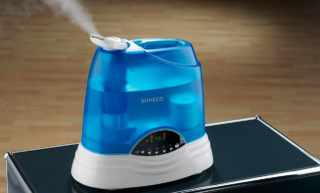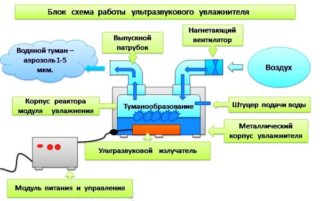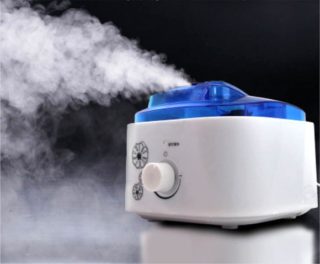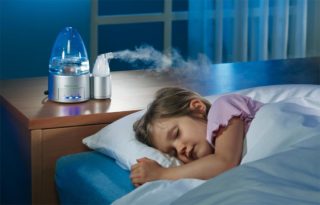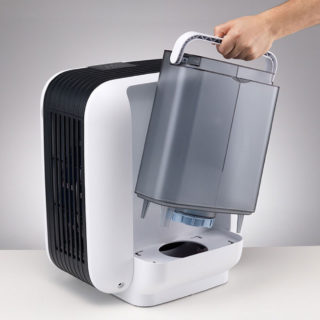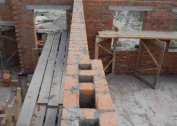All humidifiers according to the principle of their action are divided into ultrasonic models and steam devices. Users often wonder about the appropriateness of acquiring an expensive and in need of constant care ultrasonic powered device. You will need to familiarize yourself with the features of this product and with the effect that it has on family members.
The need for humidifiers
Excessively dry air, like dust accumulating over time, adversely affects the health of apartment residents and their young children. In the presence of an ultrasonic or steam humidifier, various troubles and viral diseases can be forgotten for a long time. Natural air humidity, long maintained at the right level, has a positive effect on health.
When choosing the right model, it is important to consider that in addition to wetting, this device is capable of:
- precipitate dust microparticles;
- purify air from the street from harmful bacteria;
- flavor it.
These advantages allow you to save the health of not only young children, but also newborns.
The principle of operation and device
The principle of operation of an ultrasonic humidifier:
- Water from the tank is fed to a special plate that vibrates at a high frequency characteristic of ultrasound.
- Due to high-frequency oscillations, the liquid turns into a finely divided aqueous suspension.
- The air stream created by the built-in fan directs water dust to the humidified area, where it is transformed into steam.
The pairs formed in this way resemble clubs of fog, which gradually spreads throughout the entire serviced space.
Since the human ear is not adapted to the perception of sounds in the ultrasonic range, such devices are perceived by users as completely silent. A person will be able to hear when turning on the device a slight noise of a working miniature fan.
The moisture obtained as a result of membrane vibrations is picked up by the air flow and enters the room through a special spray nozzle. The latter is designed so that the vapor mist penetrates into the most remote corners of the room.
Features of using an ultrasonic humidifier
Since water, used as a source of moisture, most often contains salt impurities dissolved in it, during evaporation they settle on surrounding objects in the form of a white coating. In addition, they accumulate on the internal surfaces of the device itself and clog the filter element in it. To protect the inside of the device from destruction and not to damage the carbon filter, it is recommended to use only purified (distilled or bottled) water for refueling.
The features and benefits of the operation of ultrasonic moisturizing devices include:
- ease of maintenance (to turn them on, just plug the plug into the outlet and press the “Start” button);
- complete silent operation;
- high hydration rate;
- the possibility of increasing the moisture content to 90%.
An insignificant disadvantage of humidifiers of this type is the formation of white coating on surrounding objects and surfaces after prolonged use of the device.
Benefit and harm
To create a comfortable microclimate in a house or apartment, an appropriate level of humidity is required. If this requirement is violated, housing tenants may experience weakness and malaise. Too humid or very dry air affects not only the condition of the person, but also on the objects surrounding him in the room.
What is the device useful for?
Steam and ultrasonic humidifiers normalize heat transfer processes in urban apartments and country houses. This has a beneficial effect on the tone of adults and children. In the children's body, more heat accumulates. If dry air prevails in the rooms, the child’s body loses moisture, which leads to a noticeable thickening of the blood and impaired functioning of the body. Speaking about the undesirable or very bad consequences of a low level of humidity in the house, one should not forget about the respiratory organs, with which problems are also possible.
A humidifying air device reduces the risks of the spread of acute respiratory infections and eliminates the likelihood of developing otitis media, bronchitis and other diseases. In addition, it prevents the propagation of allergens and the appearance of exacerbations in people dependent on this disease. In general, the effect of the device has a beneficial effect on the skin condition of adults and children.
Moisturizing helps older people who have dry skin after 60-70 years, accompanied by unpleasant “senile” itching. The general well-being and mood of all people living in the house also improves.
Moisturization has a beneficial effect on the furniture in the apartment or house, which in this case is not subject to drying out and cracking. The same can be said of domestic plants, whose development under conditions of normal humidity is noticeably accelerated.
Possible harm
When describing the useful properties of air humidifiers, one should not lose sight of the harm that can be done to a person due to improper handling. A positive effect is possible only with strictly standardized humidification, not exceeding the permissible limit. Violation of this requirement leads to the following undesirable consequences:
- deterioration in the general well-being of residents;
- the appearance in the air and on things of pathogenic fungi and bacteria;
- quick wear of surrounding things made of natural materials;
- the development of the disease in plants.
With waterlogging, its average temperature drops sharply.
How to prevent harmful effects
It is possible to avoid all of these troubles by competent handling of the humidifier, the order of which is given in the instructions. To do this, you must:
- constantly monitor the humidity level in the room;
- monitor the condition of the internal surfaces of the humidifier;
- change cleaning filters periodically.
If you follow all these recommendations, the device will last a very long time, the harmful effects from it will be minimized.
Differences between ultrasonic and steam humidifiers
In the case of a steam appliance, air is humidified by bringing the liquid filled to the boiling point. The resulting steam exits through special openings and spreads throughout the room.
A feature and disadvantage of this method is that the steam leaves the device very hot, which does not exclude the possibility of burns. For this reason, the instruction manual for steam products specifically indicates the danger of approaching the working holes. Particular attention is paid to young children who may be seriously injured.
A steam humidifier is considered more effective when you want to get maximum humidity.This opportunity is convenient for owners of premises where the hostess breeds a large number of tropical plants. In devices of this type, evaporation water is not passed through filters, which simplifies their maintenance and reduces the price.
Ultrasonic analogues of the steam device are distinguished by the fact that a special plate that oscillates with high frequency is responsible for the formation of a “fog cloud” in them. The vapors emanating from the device have a normal temperature and do not pose a threat to others. Therefore, ultrasonic humidifiers in comparison with steam humidifiers are completely safe. In addition, they are distinguished by significant performance and can be used in large apartments.
Selection tips
When choosing a suitable humidifier model, it is customary to be guided by the parameters of the device, which are of particular importance during its operation:
- unit performance;
- power of the humidifier;
- the level of noise it creates.
Performance is selected depending on the area that the device will have to service. The practice of operating ultrasonic devices has shown that for rooms up to 30 m2 A sufficient capacity is considered to be from 300 to 400 ml / hour. More productive devices can handle up to 70 m2 living space, which corresponds to a medium-sized one-bedroom apartment. This indicator for such devices reaches 500-600 ml / hour.
The power of the purchased product is directly related to its performance, which forces the user to select them through a given ratio. The correctness of this choice will save on the purchased model (it is unreasonable to overpay for surplus power and performance). The following pattern is also observed: the more options a particular model has, the higher should be an indicator of its power. At the same time, the energy consumed from the network and the costs of its payment increase.
When assessing the noise level of the purchased device, it should be noted that in winter it sometimes works for hours. If this indicator does not meet the requirements of sanitary standards, you can forget about the comfort of staying indoors. Therefore, you should choose a device whose noise characteristics are extremely low and amount to no more than 25 dB.
Service
Regardless of the type, cost and functionality, humidifying air devices need timely care. In some samples of ultrasonic humidifiers, filters have to be replaced every 3 months. Also, the service involves the following mandatory procedures:
- washing the body of the device under running water at least once a week;
- cleaning the tank from salt deposits as surfaces become contaminated;
- complete disinfection of the device, carried out at least 1 time per month.
To clean the humidifiers, special chemicals are used, which are expensive, but perfectly coping with their task. However, to eliminate pollution, it is allowed to use conventional means, for example, an aqueous solution of laundry soap.
